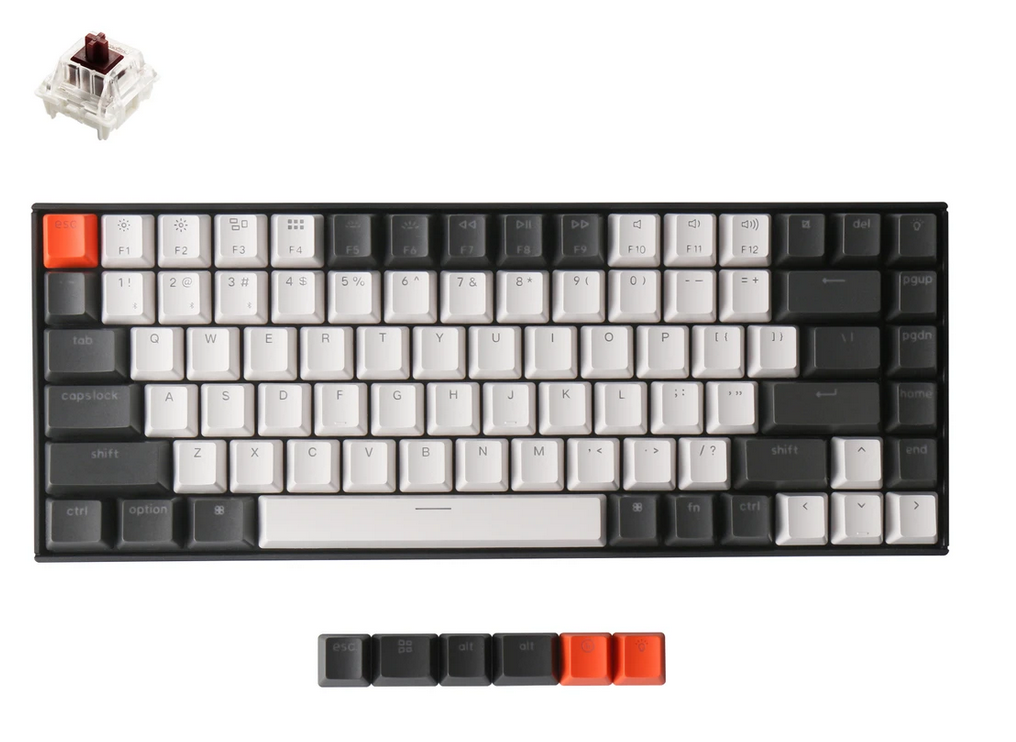Elizabeth Case
Choosing a Mechanical Keyboard

I went down a narrow but deep rabbit hole this last weekend, after my partner’s five-year old (external) Apple keyboard crapped out on me. My laptop keyboard has been going down the drain for a while now too – it’s a 2016 Macbook Pro, which has the now-outdated butterfly keys that are notorious for breaking. My a and e keys fall out regularly now, and the rest of the keyboard is on its way.
I’ve been interested in mechanical keyboards for a while. On top of nostalgic memories of clacking away on old keyboards in my dad’s office (which is, to this day, filled with technology), I’m interested in the physical experience of interacting with a digital/virtual/software-focused “space”. I think a lot about what is on my desk or where I am writing/working and how the environment contributes to the experience of work. Part of this is due to the fact that ergonomics is a nightmare for someone as small as me (5’2”). As far as I can tell, there is no (reasonably priced) office furniture made for people my size, so working often ends up being uncomfortable (feet cant’t reach the ground, or I type at shoulder level, or both), or hacked (a cardboard box under my feet).
Anyways, I haven’t put much effort into the keyboard, even though along with the mouse (I have this one – it’s portable, reliable, cheap, battery lasts forever), it is the physical tool I use most in my day.
Some advantages of mechanical keyboards:
- a lot of their parts are fixable or replaceable
- they come in myriad sizes and shapes
- they are built to last
- and most importantly, they can vastly improve your typing experience.
Many cheaper keyboards require people to overtype, or press down too hard or too far, which can be fatiguing for folks who spend a lot of time on the computer, e.g. me. With mechanical keyboards, you can choose what kind of switches you want. Where keycaps are the aesthetic covering, switches are what actually register when you press down on a key. Some switches only register at the bottom of a keypress (improving accuracy by preventing mistypes), others give tactile feedback when the keystroke registers (improving speed and requiring less typing force from you). For those who game regularly or competitively, or folks who type a lot, these decisions can change the way you interact with your computer. Switches are known by their color type), e.g. brown, red, clear, and these all indicate different properties like the force it takes to press the switch down, and whether the switch gives any feedback or makes noise.
I went into the search with a couple of desired features: a smaller board (without a numberpad, a.k.a. a tenkeyless) that would allow me to have a more ergonomic set up with my mouse; tactile feedback (clicky or a feeling of pressing the key); and wireless connectivity (not a requirement, but a want).
Naturally, I first turned to my dad, a retired technology writer. He suggested the Logitech G915TKL as having a superior typing experience (e.g. you don’t have to press hard or far). At $229, these boards were a little pricier than I, a graduate student, was willing to spend.
So I turned to the mechanical keyboard subreddit, as well as the usual places for tech recommendations: Wirecutter, Wired, random blogs, Drop, etc. I remembered a Ali Abdaal’s Youtube video where he had recommended a very aesthetic keyboard (to his credit, I searched “london doctor productivity”, which was all i could remember about him, and he showed up). That took me to IQUNIX, but again these were a bit out of my price rage (on the order of $175-199). A bit of Google searching led me to Mechanicalkeyboards.com , which sells keyboards but also has a wealth of information. A lot of their most aesthetic keyboards sell out regularly, but restock often, too. The most common introductory keyboards are made by Ducky ($99) and Leopold ($119-150). I ~almost~ went with this Leopold, which got great reviews, but then remembered I had a mac and also that keyboard is not wireless, which was a bit of a downside. On reddit, a lot of folks recommend Keychrons for introductory mechanical keyboards for mac users, and after weighing price, quality, user-friendliness, etc, I ultimately went with them, buying for $99 (incl shipping):
the Keychron K2 (hot-swappable) Wireless Keyboard with brown switches.
A quick breakdown of the keyboard:
- hot-swappable: switches can be changed out
- brown switches: tactile, but not clicky (they give feedback when computer registers the keystroke, so you don’t have to press all the way down)
- narrow board: pretty similar in size to a keyboard on a 15” laptop
- function keys: programmable (e.g. for media volume, etc)
- wireless & wired: wireless for most use; wired when I forget to recharge it (with a USB-c connection!)
- things i don’t care about but others do: rgb lighting, slightly fuzzy text on the keys
It should arrive in a week or so! I’ll update this post with a review of the keyboard.
The hole just deepens from here: check out these keycaps.
Written on January 5th, 2021 by Elizabeth Case